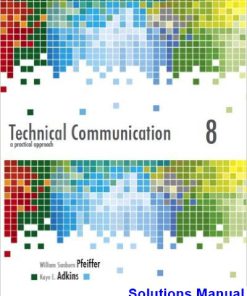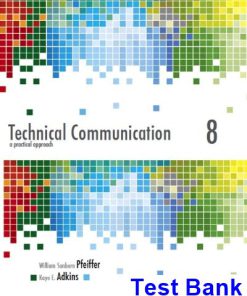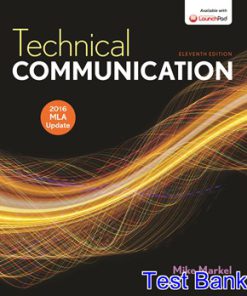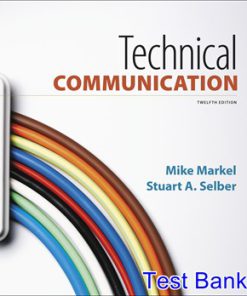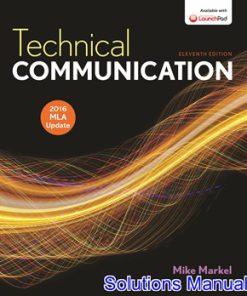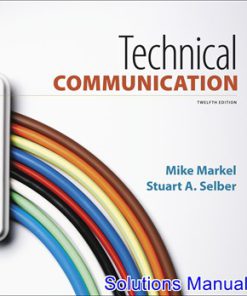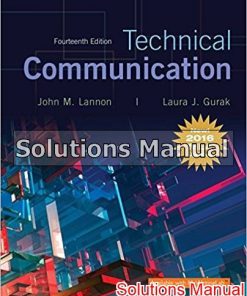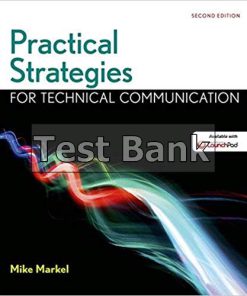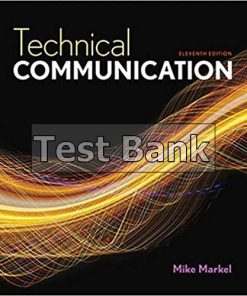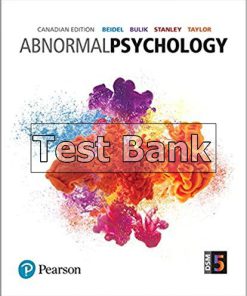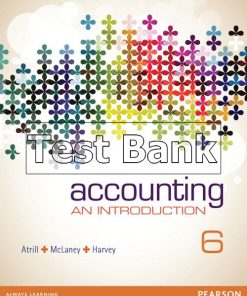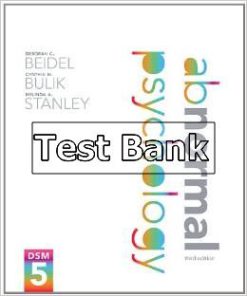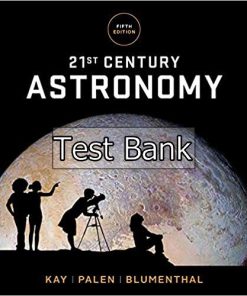Technical Communication 14th Edition Lannon Test Bank
$50.00 Original price was: $50.00.$26.50Current price is: $26.50.
Technical Communication 14th Edition Lannon Test Bank.
This is completed downloadable of Technical Communication 14th Edition Lannon Test Bank
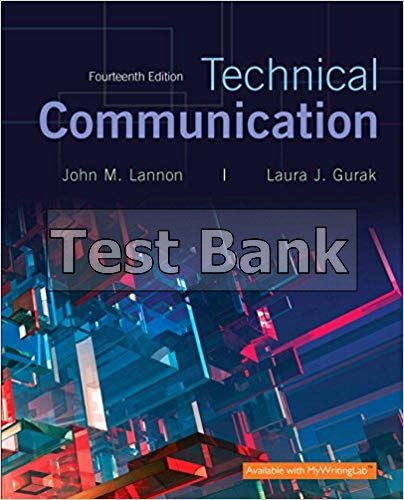
Product Details:
- ISBN-10 : 0134118499
- ISBN-13 : 978-0134118499
- Author: John Lannon, Laura J. Gurak
Today’s employees are tasked with writing documents such as emails, memos, letters, and informal reports, as well as more complex forms of communications such as formal reports, proposals, web pages, and presentations. Technical Communication, Fourteenth Edition builds upon the authority of the previous editions byclearly guiding students to write documents persuasively, effectively, and with an eye towards technological innovations and global communications. It incorporates the interpersonal, logical, ethical, and cultural demands of these different forms of workplace communications and provides students with the necessary skills to navigate these nuisances. Building on research and writing skills and touching on the importance of ethics, the authors prepare students for technical writing in any field.
Table of Content:
- Part 1 Communicating In The Workplace
- Chapter 1 Introduction to Technical Communication
- What Is Technical Communication?
- Technical Communication Is a Digital and a Human Activity
- Technical Communication Reaches a Global Audience
- Technical Communication Is Part of Most Careers
- Technical Communicators Play Many Roles
- Main Features of Technical Communication
- Reader-Centered
- Accessible and Efficient
- Often Produced by Teams
- Delivered in Paper and Digital Versions
- Purposes of Technical Communication
- Documents that Inform
- Documents that Instruct
- Documents that Persuade
- Preparing Effective Technical Documents
- Case Providing Information Readers Can Use
- Case Being Persuasive
- Case Considering the Ethical Issues
- Case Working on a Team and Thinking Globally
- Projects
- Chapter 2 Meeting the Needs of Specific Audiences
- Analyze Your Document’s Audience and Purpose
- Primary and Secondary Audiences
- Your Relationship to Your Readers
- Purpose of Your Document
- Primary and Secondary Purposes
- Intended Use of the Document
- Assess the Audience’s Technical Background
- Highly Technical Audience
- Semitechnical Audience
- Nontechnical Audience
- Audiences with Varying Technical Backgrounds
- Case Tailoring a Single Document for Multiple Audiences
- Web-Based Documents for Multiple Audiences
- Identify the Audience’s Cultural Background
- Anticipate Your Audience’s Preferences
- Length and Details
- Format and Medium
- Tone
- Due Date and Timing
- Budget
- Guidelines for Analyzing Your Audience and Its Use of the Document
- Develop an Audience and Use Profile
- Case Developing an Audience and Use Profile
- Checklist Analyzing Audience and Purpose
- Projects
- Chapter 3 Persuading Your Audience
- Identify Your Specific Persuasive Goal
- Try to Predict Audience Reaction
- Expect Audience Resistance
- Know How to Connect with the Audience
- Case Connecting with the Audience
- Allow for Give-and-Take
- Ask for a Specific Response
- Never Ask for Too Much
- Recognize All Constraints
- Organizational Constraints
- Legal Constraints
- Ethical Constraints
- Time Constraints
- Social and Psychological Constraints
- Consider This People Often React Emotionally to Persuasive Appeals
- Support Your Claims Convincingly
- Offer Convincing Evidence
- Appeal to Common Goals and Values
- Consider the Cultural Context
- Guidelines for Persuasion
- Shaping Your Argument
- Checklist Persuasion
- Projects
- Chapter 4 Weighing the Ethical Issues
- Recognize Unethical Communication in the Workplace
- Know the Major Causes of Unethical Communication
- Yielding to Social Pressure
- Mistaking Groupthink for Teamwork
- Understand the Potential for Communication Abuse
- Suppressing Knowledge the Public Needs
- Hiding Conflicts of Interest
- Exaggerating Claims about Technology
- Falsifying or Fabricating Data
- Using Visual Images That Conceal the Truth
- Stealing or Divulging Proprietary Information
- Withholding Information People Need for Their Jobs
- Exploiting Cultural Differences
- Consider Ethical Issues and Digital Information
- Rely on Critical Thinking for Ethical Decisions
- Reasonable Criteria for Ethical Judgment
- Ethical Dilemmas
- Anticipate Some Hard Choices
- Case A Hard Choice
- Learn to Recognize Legal Issues and Plagiarism
- Learn to Recognize Plagiarism
- Blatant versus Unintentional Plagiarism
- Plagiarism and the Internet
- Plagiarism and Your Career
- Consider This Ethical Standards Are Good for Business
- Decide When and How to Report Ethical Abuses
- Checklist Ethical Communication
- Guidelines for Ethical Communication
- Projects
- Chapter 5 Teamwork and Global Considerations
- Teamwork and Project Management
- Virtual Teamwork
- Guidelines for Managing a Collaborative Project
- Face-to-Face Meetings
- Guidelines for Running a Meeting
- Sources of Conflict in Collaborative Groups
- Interpersonal Differences
- Gender Differences
- Cultural Differences
- Managing Group Conflict
- Overcoming Differences by Active Listening
- Guidelines for Active Listening
- Thinking Creatively
- Brainstorm as a Way of Getting Started
- Brainstorming with Digital Technologies
- Mind-Mapping
- Storyboarding
- Reviewing and Editing Others’ Work
- Guidelines for Peer Reviewing and Editing
- Ethical Abuses in Workplace Collaboration
- Intimidating One’s Peers
- Claiming Credit for Others’ Work
- Hoarding Information
- Global Considerations When Working in Teams
- Interpersonal Issues in Global Teams
- Guidelines for Communicating on a Global Team
- Checklist Teamwork and Global Considerations
- Projects
- Chapter 6 An Overview of the Technical Writing Process
- Critical Thinking in the Writing Process
- A Sample Writing Situation
- Working with the Information
- Planning the Document
- Drafting the Document
- Revising the Document
- Make Proofreading Your Final Step
- Guidelines for Proofreading
- Digital Technology and the Writing Process
- Checklist Proofreading
- Projects
- Part 2 The Research Process
- Chapter 7 Thinking Critically about the Research Process
- Asking the Right Questions
- Case Defining and Refining a Research Question
- Exploring a Balance of Views
- Achieving Adequate Depth in Your Search
- Evaluating and Interpreting Your Findings
- Primary Versus Secondary Sources
- Exploring Secondary Sources
- Online Secondary Sources
- Locating Secondary Sources Using Google
- Locating Secondary Sources Using Wikipedia
- Other Web-Based Secondary Sources
- Guidelines for Researching on the Internet
- Traditional Secondary Sources
- Exploring Primary Sources
- Unsolicited Inquiries
- Informational Interviews
- Surveys
- Guidelines for Informational Interviews
- Guidelines for Surveys
- Observations and Experiments
- Consider This Frequently Asked Questions about Copyright
- Projects
- Chapter 8 Evaluating and Interpreting Information
- Evaluate the Sources
- Evaluate Online Information
- Evaluate the Evidence
- Interpret Your Findings
- Identify Your Level of Certainty
- Examine the Underlying Assumptions
- Be Alert for Personal Bias
- Consider Other Possible Interpretations
- Consider This Standards of Proof Vary for Different Audiences
- Avoid Distorted or Unethical Reasoning
- Faulty Generalization
- Faulty Causal Reasoning
- Faulty Statistical Analysis
- Acknowledge the Limits of Research
- Obstacles to Validity and Reliability
- Flaws in Research Studies
- Deceptive Reporting
- Guidelines for Evaluating and Interpreting Information
- Checklist The Research Process
- Projects
- Chapter 9 Summarizing Research Findings and Other Information
- Considering Audience and Purpose
- What Readers Expect from a Summary
- Guidelines for Summarizing Information
- A Situation Requiring a Summary
- Creating a Summary
- Special Types of Summaries
- Closing Summary
- Informative Abstract (“Summary”)
- Descriptive Abstract (“Abstract”)
- Executive Abstract
- Digital and Ethical Considerations in Summarizing Information
- Checklist Summaries
- Projects
- Part 3 Organization, Style, and Visual Design
- Chapter 10 Organizing for Readers
- The Typical Shape of Workplace Documents
- Outlining
- An Outlining Strategy
- The Formal Outline
- Guidelines for Outlining
- Storyboarding
- Paragraphing
- The Support Paragraph
- The Topic Sentence
- Paragraph Unity
- Paragraph Coherence
- Paragraph Length
- Chunking
- Providing an Overview
- Organizing for Global Audiences
- Checklist Organizing Information
- Projects
- Chapter 11 Editing for a Professional Style and Tone
- Editing for Clarity
- Avoid Ambiguous Pronoun References
- Avoid Ambiguous Modifiers
- Unstack Modifying Nouns
- Arrange Word Order for Coherence and Emphasis
- Use Active Voice Whenever Possible
- Use Passive Voice Selectively
- Avoid Overstuffed Sentences
- Editing for Conciseness
- Avoid Wordy Phrases
- Eliminate Redundancy
- Avoid Needless Repetition
- Avoid There Sentence Openers
- Avoid Some It Sentence Openers
- Delete Needless Prefaces
- Avoid Weak Verbs
- Avoid Excessive Prepositions
- Avoid Nominalizations
- Make Negatives Positive
- Clean Out Clutter Words
- Delete Needless Qualifiers
- Editing for Fluency
- Combine Related Ideas
- Vary Sentence Construction and Length
- Use Short Sentences for Special Emphasis
- Finding the Exact Words
- Prefer Simple and Familiar Wording
- Avoid Useless Jargon
- Use Acronyms Selectively
- Avoid Triteness
- Avoid Misleading Euphemisms
- Avoid Overstatement
- Avoid Imprecise Wording
- Be Specific and Concrete
- Use Analogies to Sharpen the Image
- Adjusting Your Tone
- Guidelines for Deciding about Tone
- Consider Using an Occasional Contraction
- Address Readers Directly
- Use I and We When Appropriate
- Prefer the Active Voice
- Emphasize the Positive
- Avoid an Overly Informal Tone
- Avoid Personal Bias
- Avoid Sexist Usage
- Guidelines for Nonsexist Usage
- Avoid Biased Usage of All Types
- Considering the Global Context
- Legal and Ethical Implications of Word Choice
- Style, Tone, and Digital Writing
- Using Digital Editing Tools Effectively
- Checklist Style
- Projects
- Chapter 12 Designing Visual Information
- Why Visuals Matter
- When to Use Visuals
- Types of Visuals to Consider
- How to Choose the Right Visuals
- Using Software to Create Visuals
- Tables
- How to Construct a Table
- Graphs
- Bar Graphs
- Line Graphs
- Guidelines for Creating Tables and Graphs
- Charts
- Pie Charts
- Organization Charts
- Flowcharts
- Tree Charts
- Gantt and PERT Charts
- Pictograms
- Guidelines for Creating Charts
- Graphic Illustrations
- Diagrams
- Maps
- Symbols and Icons
- Guidelines for Creating Graphic Illustrations
- Photographs
- Guidelines for Using Photographs
- Videos
- Guidelines for Using Video
- Using Color
- Guidelines for Incorporating Color
- Ethical Considerations
- Present the Real Picture
- Present the Complete Picture
- Don’t Mistake Distortion for Emphasis
- Cultural Considerations
- Guidelines for Obtaining and Citing Visual Material
- Guidelines for Fitting Visuals with Text
- Checklist Visuals
- Projects
- Chapter 13 Designing Pages and Documents
- Page Design in Workplace Documents
- Page Design for Print and Digital Documents
- Design Skills Needed by Technical Communicators
- Word Processing and Desktop Publishing
- Using Styles and Templates
- Using Style Guides and Style Sheets
- Creating a Design that Works for Your Readers
- Shaping the Page
- Guidelines for Shaping the Page
- Styling the Words and Letters
- Guidelines for Styling the Words and Letters
- Adding Emphasis
- Guidelines for Adding Emphasis
- Using Headings for Access and Orientation
- Guidelines for Using Headings
- Audience Considerations in Page Design
- Designing Digital Documents
- Adobe Acrobat™ and PDF Files
- Web Pages
- Tablets, Smartphones, and E-Reader Pages
- Checklist Page Design
- Projects
- Part 4 Specific Documents and Applications
- Chapter 14 Email and Text Messages
- Email Parts and Format
- Considering Audience and Purpose
- Email Style and Tone
- Interpersonal Issues and Email
- Choose the Right Tool for the Situation
- Ethical and Legal Issues When Using Email
- Privacy and Other Ethical Issues
- Legal Issues and Email
- Global Considerations When Using Email
- Guidelines for Writing and Using Email
- Text Messaging
- Guidelines for Text Messaging
- Checklist Email and Text Messages
- Projects
- Chapter 15 Workplace Memos and Letters
- Memos
- Considering Audience and Purpose
- Memo Parts and Format
- Memo Tone
- Common Types of Memos
- Transmittal Memo
- Summary or Follow-up Memo
- Routine Miscellaneous Memo
- Guidelines for Memos
- Checklist Memos
- Letters
- Considering Audience and Purpose
- Letter Parts, Formats, and Design Elements
- Standard Parts
- Optional Parts
- Formats and Design Features
- Letter Tone
- Establish and Maintain a “You” Perspective
- Be Polite and Tactful
- Use Plain English
- Decide on a Direct or Indirect Organizing Pattern
- Global and Ethical Considerations
- Guidelines for Letters in General
- Conveying Bad or Unwelcome News
- Guidelines for Conveying Bad News
- Common Types of Letters
- Inquiry Letters
- Guidelines for Inquiry Letters
- Claim Letters
- Guidelines for Claim Letters
- Sales Letters
- Guidelines for Sales Letters
- Adjustment Letters
- Guidelines for Adjustment Letters
- Checklist Letters
- Projects
- Chapter 16 Résumés and Other Job-Search Materials
- Assessing Your Skills and Aptitudes
- Researching the Job Market
- Plan Your Strategy
- Focus Your Search
- Explore Online Resources
- Learn to Network
- Résumés
- Parts of a Résumé
- Using Templates
- Organizing Your Résumé
- Guidelines for Writing and Designing Your Résumé
- Application Letters
- Solicited Application Letters
- Unsolicited Application Letters
- Guidelines for Application Letters
- Digital Versus Print Job Application Materials
- Guidelines for Digital Job Application Materials
- Consider This How Applicants Are Screened for Personal Qualities
- Dossiers, Portfolios, and E-Portfolios
- Dossiers
- Portfolios and E-Portfolios
- Guidelines for Dossiers, Portfolios, and E-Portfolios
- Interviews and Follow-Up Letters
- Interviews
- Follow-Up Letters
- Guidelines for Interviews and Follow-Up Letters
- Checklist Résumés
- Checklist Application Letters
- Checklist Supporting Materials
- Projects
- Chapter 17 Technical Definitions
- Considering Audience and Purpose
- Legal, Ethical, Societal, and Global Implications
- Types of Definition
- Parenthetical Definitions
- Sentence Definitions
- Expanded Definitions
- Methods for Expanding Definitions
- Etymology
- History
- Negation
- Operating Principle
- Analysis of Parts
- Visuals
- Comparison and Contrast
- Required Conditions
- Examples
- Situations Requiring Expanded Definitions
- An Expanded Definition for Semitechnical Readers
- An Expanded Definition for Nontechnical Readers
- Placing Definitions in a Document
- Guidelines for Definitions
- Checklist Definitions
- Projects
- Chapter 18 Technical Descriptions, Specifications, and Marketing Materials
- Considering Audience and Purpose
- Types of Technical Descriptions
- Objectivity in Technical Descriptions
- Elements of Descriptions
- Clear and Limiting Title
- Appropriate Level of Detail and Technicality
- Visuals
- Clearest Descriptive Sequence
- Outlining and Writing a Product Description
- A Mechanism Description for a Nontechnical Audience
- Outlining and Writing a Process Description
- A Process Description for a Nontechnical Audience
- Specifications
- Guidelines for Descriptions
- Types of Specifications
- Considering Audience and Purpose
- Guidelines for Specifications
- Technical Marketing Materials
- Guidelines for Technical Marketing Materials
- Checklist Technical Descriptions
- Checklist for Specifications
- Checklist Technical Marketing Materials
- Projects
- Chapter 19 Instructions and Procedures
- Considering Audience and Purpose
- Formats for Instructional Documents
- Faulty Instructions and Legal Liability
- Elements of Effective Instructions
- Clear and Limiting Title
- Informed Content
- Visuals
- Appropriate Level of Detail and Technicality
- Guidelines for Providing Appropriate Detail
- Logically Ordered Steps
- Notes and Hazard Notices
- Readability
- Effective Design
- Guidelines for Designing Instructions
- Outlining and Writing a Set of Instructions
- Introduction
- Body: Required Steps
- Conclusion
- A Complete Set of Instructions for a Nontechnical Audience
- Digital and Online Instructions
- Video Instructions
- Scripting Online Videos
- Procedures
- Evaluating the Usability of Instructions and Procedures
- Usability and the User Experience
- Approaches for Evaluating a Document’s Usability
- Checklist Instructions and Procedures
- Projects
- Chapter 20 Informal Reports
- Informational Versus Analytical Reports
- Progress Reports
- Guidelines for Progress Reports
- Periodic Activity Reports
- Guidelines for Periodic Activity Reports
- Trip Reports
- Guidelines for Trip Reports
- Meeting Minutes
- Guidelines for Meeting Minutes
- Feasibility Reports
- Guidelines for Feasibility Reports
- Recommendation Reports
- Guidelines for Recommendation Reports
- Justification Reports
- Guidelines for Justification Reports
- Peer Review Reports
- Guidelines for Peer Review Reports
- Checklist Informal Reports
- Projects
- Chapter 21 Formal Analytical Reports
- Considering Audience and Purpose
- Typical Analytical Problems
- Causal Analysis: “Why Does X Happen?”
- Case The Reasoning Process in Causal Analysis
- Comparative Analysis: “Is X Or Y Better for Our Needs?”
- Case The Reasoning Process in Comparative Analysis
- Feasibility Analysis: “Is This a Good Idea?”
- Case The Reasoning Process in Feasibility Analysis
- Combining Types of Analysis
- Elements of an Effective Analysis
- Clearly Identified Problem or Purpose
- Adequate but Not Excessive Data
- Accurate and Balanced Data
- Fully Interpreted Data
- Subordination of Personal Bias
- Appropriate Visuals
- Valid Conclusions and Recommendations
- Self-Assessment
- An Outline and Model for Analytical Reports
- Introduction
- Body
- Conclusion
- Front Matter and End Matter Supplements
- Front Matter
- Letter of Transmittal
- Text of the Report
- End Matter
- A Situation Requiring an Analytical Report
- A Formal Report
- Guidelines for Reasoning through an Analytical Problem
- Checklist Analytical Reports
- Projects
- Chapter 22 Proposals
- Considering Audience and Purpose
- The Proposal Process
- Case Submitting a Competitive Proposal
- Types of Proposals
- Planning Proposals
- Research Proposals
- Sales Proposals
- Elements of a Persuasive Proposal
- A Forecasting Title or Subject Line
- Background Information
- Statement of the Problem
- Description of Solution
- A Clear Focus on Benefits
- Honest and Supportable Claims
- Appropriate Detail
- Readability
- A Tone That Connects with Readers
- Visuals
- Accessible Page Design
- Supplements Tailored for a Diverse Audience
- Proper Citation of Sources and Contributors
- An Outline and Model for Proposals
- Introduction
- Body
- Conclusion
- Guidelines for Proposals
- A Situation Requiring a Formal Proposal
- A Formal Proposal
- Checklist Proposals
- Projects
- Chapter 23 Oral Presentations and Video Conferencing
- Advantages and Drawbacks of Oral Presentations
- Avoiding Presentation Pitfalls
- Planning Your Presentation
- Analyze Your Audience and Purpose
- Analyze Your Speaking Situation
- Select a Type of Presentation
- Select a Delivery Method
- Preparing Your Presentation
- Research Your Topic
- Aim for Simplicity and Conciseness
- Anticipate Audience Questions
- Outline Your Presentation
- Planning and Creating Your Visuals
- Decide Which Visuals to Use and Where to Use Them
- Create a Storyboard
- Decide Which Visuals You Can Realistically Create
- Guidelines for Readable and Understandable Visuals
- Choosing the Right Media Format
- Using Presentation Software
- Ethics and the Use of Presentation Software
- Case PowerPoint and the Space Shuttle Columbia Disaster
- Guidelines for Using Presentation Software
- Delivering Your Presentation
- Rehearse Your Delivery
- Check the Room and Setting Beforehand
- Cultivate the Human Landscape
- Keep Your Listeners Oriented
- Plan for How You Will Use Any Non-Computer Visual Aids
- Guidelines for Presenting Visuals
- Manage Your Presentation Style
- Manage Your Speaking Situation
- Guidelines for Managing Listener Questions
- Guidelines for Delivering Oral Presentations
- Consider This Cross-Cultural Audiences May Have Specific Expectations
- Video Conferencing
- Guidelines for Video Conferencing
- Checklist Oral Presentations
- Projects
- Chapter 24 Blogs, Wikis, and Web Pages
- Considering Audience and Purpose
- Blogs
- Internal Blogs
- External Blogs
- Wikis
- Internal Wikis
- External Wikis
- Guidelines for Writing and Using Blogsand Wikis
- Web Pages
- How People Read Web Pages
- Writing for the Web
- Guidelines for Writing Web Pages
- Designing Web Pages
- Guidelines for Designing Web Pages
- Techniques and Technologies for Creating Web Sites
- Planning Web Sites Using Storyboarding
- Teamwork When Creating Web Sites
- Tools for Creating Web Pages
- Global Issues and Web Pages
- Guidelines for Addressing Global Audiences
- Ethical and Legal Considerations
- Ethical Considerations
- Legal Considerations
- Checklist Writing and Designing for Blogs,Wikis, and the Web
- Projects
- Chapter 25 Social Media
- Considering Audience and Purpose
- Audience as Contributor
- Using Social Media for Technical Communication
- Customer Review Sites
- Google+
- Linkedin and Other Job Sites
- YouTube
- Guidelines for Writing and Using Social Media
- Ethical and Legal Issues
- Checklist Social Media
- Projects
- Part 5 Resources For Technical Writers
- A Quick Guide to Documentation
- Taking Notes
- Guidelines for Recording Research Findings
- Quoting the Work of Others
- Guidelines for Quoting the Work of Others
- Paraphrasing the Work of Others
- Guidelines for Paraphrasing
- What You Should Document
- How You Should Document
- MLA Documentation Style
- MLA Parenthetical References
- MLA Works Cited Entries
- MLA Sample Works Cited Pages
- Discussion of Figure QG.4
- APA Documentation Style
- APA Parenthetical References
- APA Reference List Entries
- APA Sample Reference List
- Discussion of Figure QG.5
- A Quick Guide to Grammar, Usage, and Mechanics
- Grammar
- Sentence Fragments
- Run-on Sentences
- Comma Splices
- Faulty Agreement—Subject and Verb
- Faulty Agreement—Pronoun and Referent
- Dangling and Misplaced Modifiers
- Faulty Parallelism
- Faulty Coordination
- Faulty Subordination
- Faulty Pronoun Case
- Punctuation
- Period
- Question Mark
- Exclamation Point
- Semicolon
- Colon
- Comma
- Apostrophe
- Quotation Marks
- Ellipses
- Brackets
- Italics
- Parentheses
- Dashes
- Mechanics
- Abbreviation
- Hyphenation
- Capitalization
- Numbers and Numerals
- Spelling
- Usage
- Transitions
- Use Transitional Expressions
- Repeat Key Words and Phrases
- Use Forecasting Statements
- Lists
- Embedded Lists
- Vertical Lists
- Works Cited
- Index
People Also Search:
technical communication lannon
technical communication 14th edition lannon
technical communication
technical communication 14th edition
technical communication 14th edition download scribd
technical communication 14th edition testbank download pdf
Instant download after Payment is complete
You may also like…
Solutions Manual
Technical Communication 14th Edition Lannon Solutions Manual




